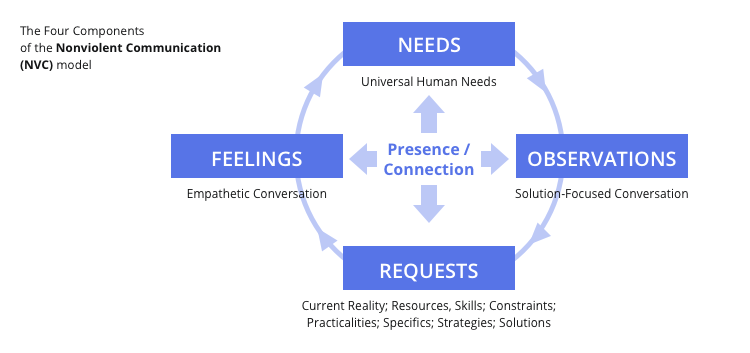Effective and actionable feedback is vital for successful projects. However, a recent research by Leadership IQ reveals that fewer than half of employees know if they’re performing well. Trying to improve with no direction is a challenge regardless of the percentage of employees who know if they’re performing well.
Even if you’re aware of the importance of regular feedback sessions, you still need to be open to working on your feedback delivery skills to be a better leader. At present, 57% of employees claim that their leaders are not doing a very good job at providing constructive feedback that can help them improve. We’ve investigated this issue and found a tried and tested framework that will help you make communication actionable and effective.
Have you ever heard about Nonviolent Communication, a technique that makes difficult conversations easier? An American psychologist, Dr. Marshall Rosenberg, developed the Nonviolent Communication (NVC) approach in the 1960s. Since that time, the approach has gained massive popularity and has been scientifically proven to be effective. In 2012 psychologists Dr. Jane Marantz Connor and Dr. Robert Wentworth examined the impact of six months of NVC training and coaching on 23 executives at the Fortune 100 companies and concluded that “conversations and meetings were notably more efficient, with issues being resolved in 50–80 percent less time.”
Dr. Rosenberg also wrote a book called Nonviolent Communication: A Language of Life, where he explains that for centuries our culture has taught us to think and speak in ways that can spark conflict:
“Most of us have been educated from birth to compete, judge, demand, and diagnose – to think and communicate in terms of what is ‘right’ and ‘wrong’ with people. At best, communicating and thinking this way can create misunderstanding and frustration.”
By following his observations, Dr. Rosenberg developed the NVC framework to empower people to cooperate, resolve existing conflicts, and prevent future ones. He highlighted four main parts of the approach – observations, feelings, needs, and requests – which you can find in the graphic below:
Following this four-step approach can help you make your conversations more organized, bold, and actionable. Here’s a step-by-step guide to follow when structuring your feedback:
1. Mention specific actions of the person you’re giving feedback to. For example, mention specific cases when the team member underperformed or performed well. It’s better to start this part of your feedback with such phrases as What I observe/When I see/hear…
2. Describe feelings and effects provoked by the person’s actions or the impact those actions have had on the project, team, company. In this part, mention the results and achievements that were or weren’t delivered over a certain period of time and the impact this had on the project in general. You could say: I feel …
3. Define needs by saying what you want or need to be changed. Here, you need to explain how you would like the situation to change: Because I need/value…
4. Make a request at the end of your feedback. When you’re done providing facts, describing the impact, and defining needs, name the exact actions or describe the type of performance you expect from the team member in the future: Would you be willing to…?
Read more: The Secret Behind Constructive Feedback Revealed
This simple yet transformative approach has many followers around the world, with people incorporating it into their daily lives. Yoram Mosenzon, a certified trainer in Nonviolent Communication, takes a funny, personal, and honest look at the way we approach communication in his TED Talk called “Vulnerable honesty.” Mosenzon talks about the roots of the Nonviolent Communication approach as well as lessons people can learn from it. He explains how personal judgment can alter the way we see certain situations and cause us to respond in a way that might provoke negative feedback in listeners. This TED Talk will be helpful for project managers, team members, and even your family members.
Here’s a practical example of feedback provided in two ways: first, based on personal judgment; second, driven by the rules of Nonviolent Communication:
Uneffective: “I am very frustrated with your performance because you seem to slack most of the time and you’re doing the tasks wrong. I am not even sure if you’re good enough for this job.” – In this example, the listener receives only negative feedback that will make them feel bad about their performance and won’t even give them a clear idea of how to improve or what to do differently.
A better way to communicate based on NVC: “You failed to deliver three project milestones on time [fact], and as a result, our project got delayed for two months and your colleagues weren’t able to complete their part of the job on time [impact]. For this project to succeed, we need you to change your attitude to your work and become better at time management [need]. As an option, you can get a planner and schedule all your activities in it to make sure that you deliver your part of the project on time in the future [requests].” – In this case, the listener receives well-reasoned feedback about their performance and gets advice on how to improve it without being verbally humiliated or over-criticized.
Read more to know how Epicflow PM software helps you deliver projects on time.
What do you think about this approach? In the comments, share your experience with the Nonviolent Communication framework and how it has helped you strengthen your personal and professional relationships.


